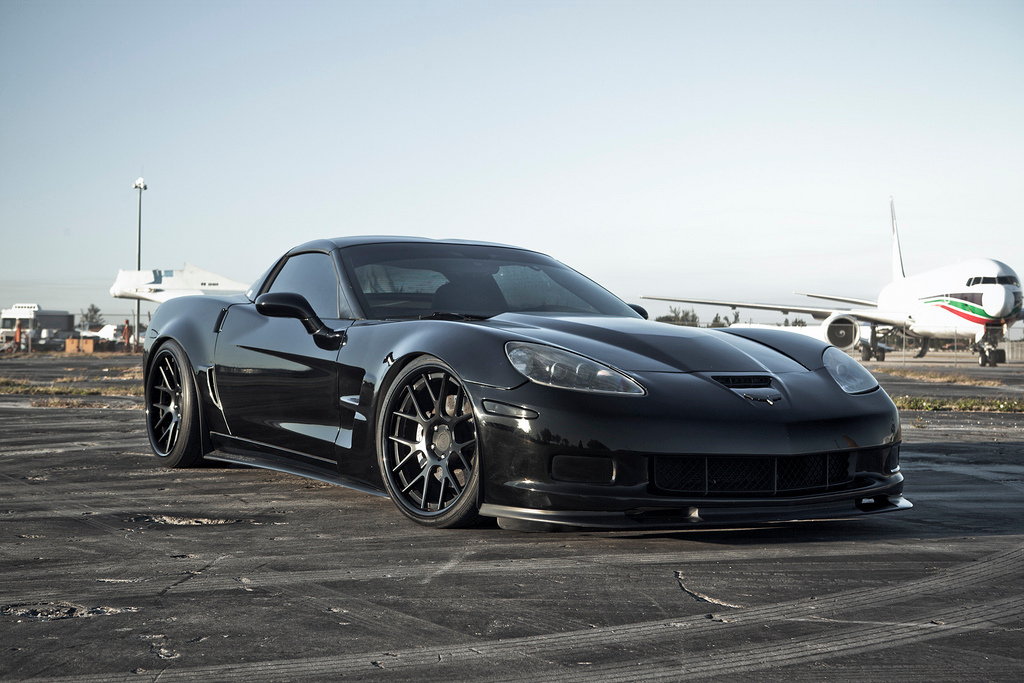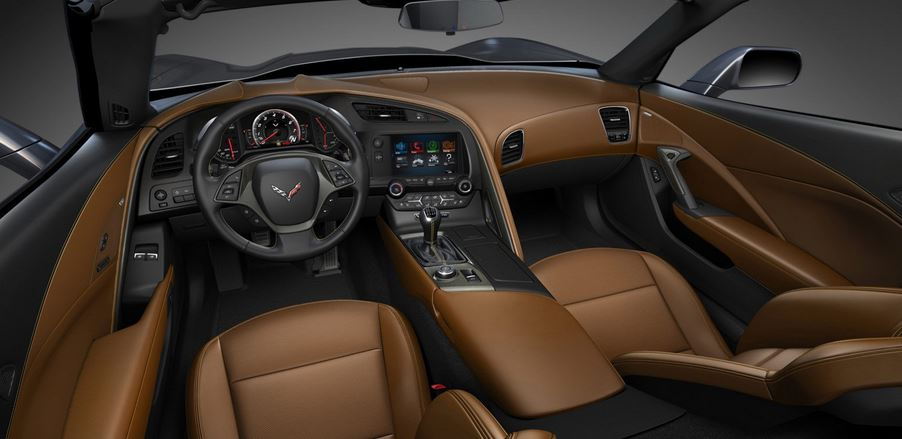C6 C7 Corvette: C6 vs. C7
The C6 has been the Corvette to get for the longest time, but has the C7 taken its place?
This article applies to the C6 and C7 Corvette (2005-2019).
By the end of the sixth generation, the evolution of the C6 was complete. GM had reintroduced the Z06, ZR1, and Grand Sport, and with a final year 427, 60th Anniversary convertible, the C6 had achieved phenomenal success. The next generation Corvette would have some big shoes to fill.

Although originally planned for the 2011 model year, the new C7 Corvette was introduced to the world at the North American International Auto Show in Detroit on January 13, 2013. The 2014 Corvette was designed to make a much bolder styling statement than past generations and introduce an interior makeover to put complaints to rest. The redesign, although revolutionary, incorporated iconic Corvette themes and, for the first time since 1976, was badged as a “Stingray.”

Key Differences
It would definitely take less time to explain what hasn’t changed with the introduction of the C7. There are only two components that were carried over from the C6: the cabin air filter and the rear hatch for the removable roof panel. Basically, GM wanted to produce a lighter car with more power, better fuel economy, improved handling, and better aerodynamics and driver enhancements, all with new premium components.
Performance
Engine
Mid-engine and rear-engine designs were rumored and originally considered, but the front-engine design was eventually retained to keep costs in line. Although the 6.2 liter, overhead valve, pushrod design V8 small block remained, the new LT1 engine increased horsepower to 455. Despite being greater than the base C6, it is actually, in the first installment of the Gen 5 engines, comparable to the LS7 engine found in the previous generation’s Z06.

Fuel Economy
Fuel economy had been improved with the C6 as it incorporated Computer Aided Gear Shifting (or CAGS), where the driver was obligated (with a manual transmission) to shift from 1st directly to 4th when operating at low RPM. Instead, the C7 achieved even better fuel economy using direct injection and variable valve timing, along with cylinder deactivation (Active Fuel Management), where the LT1 would “switch off” four of its eight cylinders while cruising at a constant speed or while braking. While the C6 achieved a rating of 26 MPG, the C7 approaches 30 MPG.
Transmission
Although there seems to be a trend towards automatic “paddle-shifting” transmissions, the folks at GM decided to “stick” to their Corvette roots and instead added another gear. The 7-speed gearbox almost seems to “think” faster than the driver as the active rev match feature predicts which gear you are going to select next. A sensor in the gearbox matches revs to road speed. You can, if so desired, turn this feature off, but once you get used to it, you may never want to.
Weight
Rumors again swirled throughout the world of Corvette enthusiasts that the new C7 would be considerably lighter than the C6. Yet, although new and advanced lighter-weight material is used throughout the car, many other components actually weigh more, and the new generation tips the scales at about the same weight.
The all-new aluminum frame, produced for the first time in-house in Bowling Green, helped maintain the ideal 50/50 weight ratio, but cut the weight by 99 pounds, all the while making the C7 57% stiffer than the C6. Although the fenders, doors, and quarter panels remain fiberglass composite, the hood and roof panel is carbon fiber, saving even more weight.

However, weight was gained in several areas on the new Corvette, albeit useful and important ones that help make it a stronger car. Direct injection, bigger brakes, the driveshaft, the clutch, the larger fuel tank, the transmission, and even the seats on the C7 weigh more than on the previous generation. In the end, the base C7 actually weighs 90 pounds more than the base C6. Yet, when you consider that performance of the base C7 is more comparable to the C6 Grand Sport, the new Stingray actually weighs in at 13 pounds less!
Exterior
Styling
When the C7 was unveiled, it defiantly made a bold styling statement. Although the C6 is a great-looking car, the new Corvette looks striking and exotic in comparison.
Yet there seems to be a back-and-forth argument among Corvette enthusiasts; more literally, a forward and aft one. When the C5 was introduced, all the styling talk focused on the large rear fascia. With the introduction of the C6, the discussion moved to the front of the car, as the headlights were exposed for the first time since 1962. The new C7 brings the styling controversy issue back to the rear. The most noticeable styling cue missing in the new Corvette is the iconic round tail lights. Round tail lights are what most other drivers saw since 1961! Instead, GM incorporated a more modern and aggressive, angular tail light assembly.
This trapezoid-style light cluster first appeared on the new fifth generation 2010 Camaro, and many felt that the Corvette had taken styling cues from the Camaro rather than the other way around. All manufacturers pass on styling cues across model lines, but usually to incorporate higher-end model styling into their less-expensive siblings, not the other way around. Since the designers were working on both models around the mid-2000s, it could be argued that the Camaro simply hit the streets ahead of the new Corvette as the original C7 release date was delayed. Regardless, it's a personal choice, and for someone who doesn’t like it, you can find someone who does. Having said that, rumors of a C8 concept drawing suggest that we may soon see the return of round tail lights.

Function
Since the C4, GM designers have aggressively pursued aerodynamic perfection. The designers of the C7 were no different. Although the C6 ran through many wind tunnel tests, the new generation Corvette took form and function to a new level.
Aerodynamics are considered in everybody feature of the C7. Whether tacked on or cut out, the exterior styling departs from smooth and muscular and introduces sharp angles. Previous generations often incorporated non-functioning styling cues like grilles, whereas the new C7 features hood vents and inlets that actually function to cool several components and aid in aerodynamic downforce and stability. The front of the car is designed to eat up air and cool the downward-facing radiator, while the rear quarter-panel side vents take in air, cooling the differential and transmission before exiting through teardrop vents in the rear fascia.

Interior
Styling
Arguably the biggest difference in the new generation Corvette is the interior. Special care and attention was given to the all new interior, as every contact surface is either soft-touch plastic, carbon fiber, aluminum, or leather. The new standard heated and ventilated seats are generously wrapped in premium Napa leather, with a wide range of power lumbar and bolster adjustments. Although 17 pounds heavier than the seats in a C6, they are incredibly comfortable whether you're strapped in for some aggressive driving or settled in for a long cruise.

Function
Despite the fact that the new C7 “Infotainment” system at 31.5 pounds weighs more than any single component in the car, the feature is simply amazing. Accessing this system through two hi-definition screens is highly intuitive and easy to manage.
The display gives the driver access to 69 different sources of information all while monitors feed information into the car’s “brain.” Gauges are customizable, giving you control over exactly which information is important to you. The gauges themselves also adapt. For example, when the engine is cold, the tach will lower the redline until the engine warms so that you won’t over rev it and cause damage.

Depending on your “Drive Mode Selection” (Weather, Eco, Sport, Tour, or Track), changes are made to transmission shifting, throttle control, chassis rigidity, steering feel, and traction control, just to name a few. More importantly, the system does not incorporate attention-grabbing sub-menus as it simply adjusts 12 parameters within the five modes to suit the current driving situation. In a way, it either acts for you or seems to anticipate your actions.
The C7 Corvette is simply stunning. Not to take anything away from the C6 or any other previous generation, but the folks at GM have created the most impressive Corvette to date. It has been said that it is basically three cars in one; speed and handling for performance, fuel economy for a pleasant commute, and comfort and amenities to handle a long cruise with ease. Revolution or evolution? It’s up to you to decide. But consider that the C7 Corvette may just very well be the perfect blend of both.
Related Discussions
- C6 vs. C7 - CorvetteForum.com
- C6 vs. C7 Comparison - CorvetteForum.com
- General Comparison - CorvetteForum.com






